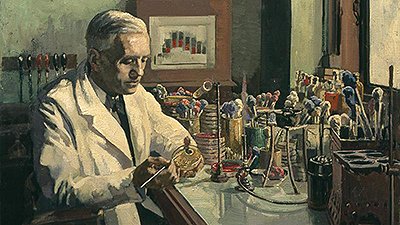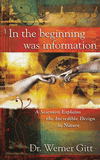Is Intelligent Design Dead?
We can all agree that evidence of intelligent design has been “shot down.” But is it good science or biased presuppositions that is doing the “shooting”?
News Source
One premise of intelligent design advocates are examples of “irreducible complexity,” where all the components of a biological system must have been in place, functioning correctly, from the beginning for the system to have worked at all—such as is the case with a (human-designed) mousetrap. According to intelligent design advocates, this indicates that step-by-step evolution (à la Darwin) cannot explain all biological systems.
Although young-earth creationists’ defenses of design in nature do not rest on the idea of irreducible complexity, we do find it to be a fair argument (in principle). That said, determining which biological systems are supposedly “irreducible” is not always easy.
Brandon Keim, writing in Wired magazine, reports on research newly published in Proceedings of the National Academy of Sciences1 that purports to show the reducible complexity of “a mitochondrial molecular machine.” Keim writes,
[N]ew research comparing mitochondria, which provide energy to animal cells, with their bacterial relatives, shows that the necessary pieces for one particular cellular machine—exactly the sort of structure that’s supposed to prove intelligent design—were lying around long ago. It was simply a matter of time before they came together into a more complex entity.
Without even reading on, let’s stop for a moment and consider some of the questions and objections we might have with the team’s research:
- What are the “necessary pieces”? What determines whether a piece is necessary or not? How complex are the necessary pieces? Are they in the same, or in different forms? (After all, all life-forms share many of the same fundamental pieces; finding them in any two life-forms is no surprise.)
- How did the scientists determine that the pieces were “lying around long ago”?
- On what scientific basis do the authors conclude that it was “simply a matter of time” before the pieces came together in a “more complex entity”? (I.e., what evidence is there that the pieces—if they did exist—were able to come together in the right manner, correct proportions, etc., to function as they do?)
How did the scientists determine that the pieces were “lying around long ago”?
Evolutionists believe that mitochondria (a cell organelle) are descended from bacteria that were, at some point, engulfed by independent cells in the beginnings of an endosymbiotic relationship. That’s why finding the same “pieces” in bacteria as in mitochondria are necessary for an evolutionist.
A “protein machine” called TIM23 is part of the workings of mitochondria. TIM23 delivers other proteins to the mitochondria that originate elsewhere in the cell. Bacteria don’t have TIM23, so evolutionists must conclude it evolved in mitochondria. But, as Keim writes, “This seems to pose a cellular chicken-and-egg question: How could protein transport evolve when it was necessary to survive in the first place?”
So what is the big breakthrough the scientists have found to answer the question—and how does it answer our questions posed above? Keim explains, “When they analyzed the genomes of proteobacteria, the family that spawned the ancestors of mitochondria, [the] team found two of the protein parts used in mitochondria to make TIM23.”
The authors note that “[a]lthough the bacterial proteins function in simple assemblies, relatively little mutation would be required to convert them to function as a protein transport machine.” According to Keim, “Only one other part, a molecule called LivH, would make a rudimentary protein-transporting machine—and LivH is commonly found in proteobacteria.”
Michael Gray, a cell biologist at Dalhousie University who was not involved in the study, commented, “These three proteins don’t perform precisely the same function in proteobacteria, but with a simple mutation could be transformed into a simple protein transport machine that could start the whole thing off.”
Which brings us back to our questions. First of all, even if the two TIM23 protein parts found in the proteobacteria were found together with LivH, would that function sufficiently for the survival of mitochondria? Keim says the result would be “rudimentary,” but we wonder how much the scientists even know about the exact workings of TIM23.
Second—and more importantly—how would the TIM23 pieces self-assemble? If the team’s hypothesis is correct, bacteria given the necessary pieces should be capable, given ample time, of assembling and operating a basic TIM23 protein delivery system. Yet Gray and the authors note the mutations that would be required. How simple are these mutations, and how frequently are they observed in bacteria?
Gray and the authors note the mutations that would be required.
Our guess is that, posed with such questions, the researchers would say that over millions of years some proteobacteria (somewhere along the line) had the right protein pieces, LivH, and the right mutations, and that all of it came together in just the right way, simultaneously—the apparatus aligning perfectly to become functional, even if just in a rudimentary sense. Voilà; the “irreducibly complex” structure becomes reducibly complex and thus explainable evolutionarily. (The scientists presumably have faith that other examples of irreducible complexity will turn out the same way.) Given that, we have two objections:
- If the scientists agreed with our description in the previous paragraph, then we would note that it in no way advances the creation/evolution debate. These scientists have faith that the apparatus could have formed stepwise in a chance occurrence; but it remains untestable from a scientific standpoint, because it becomes a “once every million years” occurrence. Plus, we remain skeptical of the constructive power of such mutations. Thus, the debate remains an untestable argument over the unrepeatable past, and this explanation becomes one of several evolutionary “rescuing devices” to avoid the conclusions of irreducible complexity.
- Also, we’ll note that supernatural creation does not require that every function—or even any—be shown to be irreducibly complex. Even if the evolutionary origin of TIM23 sounded completely plausible to us, how can any scientist demonstrate that the supernatural creation of TIM23 (etc.) isn’t also plausible (without wading in to saying what he or she thinks God “would have done”)? As we have said before, for young-earth creation to be logically plausible, (old-earth) evolution would not have to be implausible (though we think it is, for many reasons).
Having decided against creation, evolutionists, it seems, choose evolution by default as the only remaining possibility and are consequently forced to defend its plausibility no matter what—even if it means generating rescuing devices to explain the origin of complex biological features in a manner scientists have never observed in nature.
Further Reading
- The Intelligent Design Movement
- Is the Intelligent Design Movement Christian?
- Irreducible Complexity: Some Candid Admissions by Evolutionists
- Get Answers: Design in Nature, Information Theory, Probability of Evolution
For More Information: Get Answers
Remember, if you see a news story that might merit some attention, let us know about it! (Note: if the story originates from the Associated Press, FOX News, MSNBC, the New York Times, or another major national media outlet, we will most likely have already heard about it.) And thanks to all of our readers who have submitted great news tips to us. If you didn’t catch all the latest News to Know, why not take a look to see what you’ve missed?
(Please note that links will take you directly to the source. Answers in Genesis is not responsible for content on the websites to which we refer. For more information, please see our Privacy Policy.)
Footnotes
- Abigail Clements et al., “The Reducible Complexity of a Mitochondrial Molecular Machine,” PNAS 106, no. 37 (September 15, 2009): 15791–15795, doi:10.1073/pnas.0908264106
Recommended Resources

Answers in Genesis is an apologetics ministry, dedicated to helping Christians defend their faith and proclaim the good news of Jesus Christ.
- Customer Service 800.778.3390
- © 2024 Answers in Genesis






